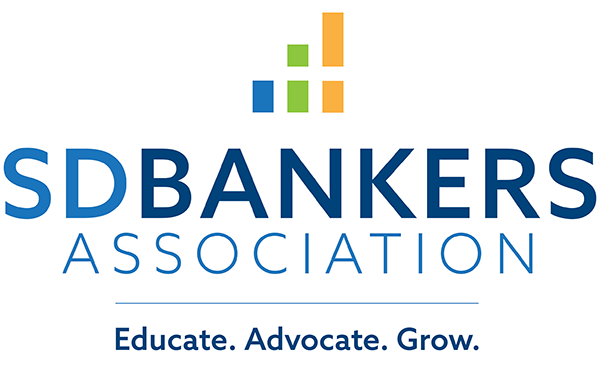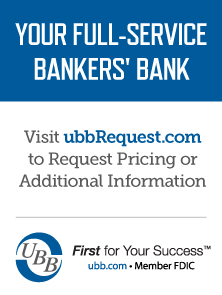- Education & Events
- Advocacy
- Products & Services
- Membership
- Resources
- SDBANKER Magazine
- SDBA eNews
- SDBA eNews Archives
- Legislative Update/Bill Watch
- South Dakota Bank Directory
- Women in Banking
- Scenes of South Dakota Calendar*
- Holiday Signs
- Regulatory Report
- South Dakota Banking Code
- Record Retention Manual
- Advertising & Sponsorship Guide
- COVID-19 Resources
- Mental Health and Crisis Prevention
- About
|
Memorandum for Remote Work Staff of South Dakota Banks
The Division is providing this guidance to assist bank management with defining remote work conditions and corresponding security protocols. South Dakota bank staff may conduct banking activities provided the remote work location is physically located in South Dakota and adequate security protocols are implemented. With respect to remote work in other states, it is permitted to the extent it follows this guidance and allowed by the host state regulatory authority. Banks that allow remote work by their employees must draft and implement comprehensive policies and procedures to ensure remote work is conducted in a secure and professional manner. A comprehensive remote work program should implement, at minimum, the following requirements and limitations: 1. Ensure in-person interactions with customers and consumers are not conducted at the
remote work location and the remote location is not represented as a business location,
branch, or Loan Production Office (LPO);
2. Maintain secure virtual private networks or similar system and other appropriate
safeguards for customer data, information, and records;
3. Ensure employees have secure internet connections and all security updates and patches
are up to date on all remote devices;
4. Employ appropriate risk-based monitoring and oversight processes of work performed
from a remote location and maintain records of the oversight process;
5. Ensure customer information and bank records are not maintained at the remote location;
6. Ensure customer information and bank records remain accessible and available for
regulatory oversight and examination;
7. Provide appropriate employee training to keep all conversations about and with
customers conducted from the remote location confidential, as if conducted from a bank
branch or LPO, and to ensure remote employees work in an environment that maintains
confidentiality. Banks with employees working remotely at the time this guidance is issued must take immediate steps to come into compliance with this guidance. Many states require banks to register with their Secretary of State or equivalent before business development or loan officers are permitted to operate in their state. If bank employees were meeting with customers or potential customers at the bank employee’s remote work location prior to the issuance of this guidance, the bank must take immediate steps to change their business practices, establish a branch or LPO, or both. If you would like additional information, or if you have any questions, please do not hesitate to contact the Division at 605-773-3421. Eight Banks Added to ABAQ IndexABA has added eight banks to the ABA NASDAQ Community Bank Index (ABAQ), effective today. The index includes 288 community banks with $256.2 billion in market capitalization and is calculated on a total return and price return basis. Newly eligible companies are added on June 1 and Dec. 1. Additions are: BayFirst Financial Corp., St. Petersburg, Florida; CFSB Bancorp, Quincy, Massachusetts; Finward Bancorp, Munster, Indiana; FinWise Bancorp, Murray, Utah; FVCBankcorp, Fairfax, Virginia; John Marshall Bancorp, Reston, Virginia; NSTS Bancorp, Waukegan, Illinois; and Third Coast Bancshares, Humble, Texas. Additionally, Tulsa, Oklahoma-based BOK Financial was removed from the index because it is now chartered among the 50 largest banks. The index, launched in 2003, represents all Nasdaq-listed banks and savings associations except the 50 largest banks and those with international or credit card specializations. ABAQ is the most broadly representative stock index for community banks and remains an important tool for giving banks more visibility with analysts and investors.
ABA, CBA Express Support for CFPB’s Nonbank Supervision, Opposition to Disclosure of CSIThe American Bankers Association and the Consumer Bankers Association this week expressed support for the Consumer Financial Protection Bureau’s recent announcement that it will increase nonbank supervision. The CFPB is authorized for two years to supervise nonbanks that present an immediate risk of harm to consumers. At the same time, the associations expressed opposition to the CFPB’s procedural rule to establish a process for the agency to release publicly all or part of any decision or order subjecting a nonbank to the agency’s supervision. “The public release of this information would set a harmful precedent by disclosing confidential supervisory information,” ABA and CBA said. “The release also will not provide helpful guidance to regulated entities because the decision or order will be based on inchoate risk assessments resting on incomplete and potentially inaccurate information, not verified illegal conduct based on a full record and analysis.” The associations instead called for the CFPB to publish a list of nonbanks that are under its supervision and issue editions of Supervisory Highlights that describe the agency’s identification of illegal conduct by nonbanks. The associations also urged the CFPB expeditiously to initiate separate rulemakings to define data aggregators and nonbank consumer installment lenders as larger participants in their respective markets. How Banks Can Effectively Use Two-Way TextingAs banks look to earn the business, trust and loyalty of more people, bank executives should consider ways to differentiate from the increasingly crowded market of banks, financial institutions and fintech providers. Enhancing customer service options are important ways to stand out from competitors while truly serving clients. According to a previous Microsoft State of Global Customer Service Report, nearly 70 percent of respondents favorably view brands that engage in proactive customer service. Customer service, which can be hard to come by for other financial entities, can be a cornerstone of bankers’ sales and marketing plans. SMS texting has gained steam among banks in recent years for good reason. According to survey results from Review.org, Americans check their phones 344 times per day. Banks can take advantage of this by utilizing text messages in a new way that meets people where they already are—on their phones). Rather simply talking to your customers with one-way SMS, open up the conversation to talk with your customers by utilizing two-way texting. Running a successful two-way texting initiative takes a bit more consideration than scheduling and sending one-way communication. Here are six best practices to keep in mind to ensure two-way texting works to benefit both your bank and its customers. 1. Assign a local texting number to each branch or market. When it comes to choosing a financial institution, bank branches have a major advantage: They are local. Customers will want to text with someone who is local, too. When using a business SMS service, you can typically request a dedicated number in your local area code. If you have branches in multiple cities, get dedicated numbers for each of their respective area codes. This is the best way to promote that local presence without leaning on employees’ personal phone numbers for texting (which should be avoided at all costs). 2. Keep the phone number consistent across communications. Ensure the texting software you select enables something called a common inbox so your staff can login and respond to customers from the same number to avoid customer confusion. This dedicated number will also give customers the opportunity to store the number in their phone so they can text it again in the future. You can safely publish that number on places such as your website and Google business listing without fear of it becoming outdated. Some providers change the phone number for clients every month or so, which needs to be avoided for consistency’s sake. 3. Assign trained staff to manage conversations. Banks will want to assign at least a few people to manage the two-way texting initiative and adjust as needed based on how often it is utilized by customers. Some software will allow administrators to set up two-way texting either from a mobile device or computer, adding even more convenience and ability to respond to customers. 4. Respond in a timely manner. Speed matters in texting. It is, in fact, one of its major benefits. According to research from OpenMarket, 83 percent of millennials open SMS messages within 90 seconds of receiving them. It is safe to assume they expect the same kind of promptness from business texting. As such, bank leaders will want to ensure texts received from customers or prospects are responded to quickly. Ideally, this means messages are responded to within minutes, and up to an hour after text receipt should be the absolute longest accepted. If there are times when staff cannot respond (likely when the branch is closed), set up an automated message that informs people when they can expect a response. 5. Keep private information away from text. As with one-way texting, avoid sharing private information. Banks can use texts to inform someone of something related to an account, but they should not share account details, such as balances and personal identifying information. 6. Make opt-in and opt-out easy. Give customers the opportunity to sign up for texting when they start a new account. For existing customers, prompt them when they log into their accounts. Equally as important as opt-in is opt-out. On all initial outgoing messages, include a phrase such as: “Text STOP to opt out.” If a customer initiates the text or the bank is responding in a chain of messages to the same customer, the messages don’t need to include the opt-out language every time, though the bank should still allow the recipient to utilize the opt-out keyword (STOP) to block the number or be unsubscribed from the SMS list at any time. Think of two-way texting as an alternative to email, chat boxes and phone calls. As more people lean toward texting as their preferred form of communication, business-to-consumer texting is increasing at a faster rate than email and phone calls. According to Juniper Research, businesses sent a total of 2.7 trillion texts in 2020, up 10 percent over the previous year. Offered two-way texting, customers get to choose how they prefer to communicate, giving them the individual attention they expect from their banks. Now that some best practices have been defined, let’s explore how two-way texting can be utilized within banks. Consider two-way texting for:
There are many reasons to utilize two-way texting, and it’s important to note that it’s the customers who will determine exactly how the service is utilized within any particular bank. Once two-way texting capabilities are secured, let customers know about this new customer service feature that allows them faster, more convenient access to local bank workers who are ready and happy to serve them. CISA News Tip of the Week: Ransomware Readiness AssessmentCyber Security Evaluation Toll (CSET) Do-It-Yourself https://github.com/cisagov/cset/releases/tag/v10.3.0.0 CSET® is a stand-alone, do-it-yourself desktop application that guides an organization through a systematic process of evaluating Operational Technology and Information Technology. CSET includes a Ransomware Readiness Assessment (RRA) module! It can be downloaded off the CISA Github site.
Few Seats Remain for 2022 Graduate Banking School - Apply ASAPJuly 31-August 12, 2022
University of Wisconsin-Madison
Madison, Wisconsin Since 1945, the Graduate School of Banking at the University of Wisconsin-Madison (GSB) has helped develop banking leaders through a program of advanced management education. Today, GSB is widely recognized as the nation's leading and most progressive banking school, offering a comprehensive course of study that focuses on meeting the changing needs of today's bank manager. GSB is the only graduate banking school in the nation that relies on its alumni, Banker Advisory Board and Academic Committee to create a unparalleled learning and networking experience. GSB is sponsored and governed by the Central States Conference of Bankers Associations in partnership with the University of Wisconsin-Madison, and has been the school of choice for more than 23,000 bankers, with good reason. GSB students acquire a broad knowledge and understanding of major bank functions and their interrelationships and develop the skills required to lead and manage effectively. The school's curriculum reflects the contemporary trends impacting the financial services industry. Core courses address broad areas of finance, marketing, management and the environment in which banks operate while elective courses allow students to customize their learning experience. Graduates of the GSB program also receive the prestigious Certificate of Executive Leadership from the Wisconsin School of Business Professional and Executive Development -- the highest level certificate they offer. Click here for more details and to apply. Juneteenth Day of ObservanceSouth Dakota Bankers Association and South Dakota Bankers Insurance and Services will be closed on Monday, June 20th in observance of the Juneteenth National Independence Day. We will re-open at 8 a.m. CDT on Tuesday, June 21st.
Registration Open for 2022 SDBA Agricultural Credit Conference - July 20-21 in Pierre, SDThe South Dakota Bankers Association will present the 2022 Agricultural Credit Conference, July 20-21, at the Ramkota Hotel & Conference Center at 920 W. Sioux Ave. in Pierre, SD. This conference focuses on the unique needs of ag bankers, and the desire for quality information and training to better serve their customers. The SDBA has lined up speakers on a variety of timely topics to help ag bankers navigate through challenging times. New or experienced ag lenders, as well as CEOs will all benefit from this conference. Click here to view the full agenda and to register. Compliance Alliance offers a comprehensive suite of compliance management solutions. To learn how to put them to work for your bank, call (888) 353-3933 or email [email protected] and ask for our Membership Team. For timely compliance updates, subscribe to Bankers Alliance’s email newsletters.
SDBA eNews Archive Advertising Opportunity Questions/Comments |



